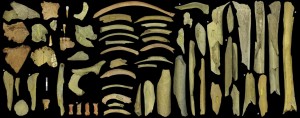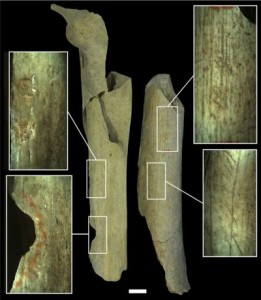7 Luglio 2016
 La collezione di ossa di Neanderthal dalla terza grotta di Goyet, con il coinvolgimento di almeno 5 individui. Quelle con asterisco daterebbero tra 40.500 e 45.500 anni fa. Credit: Asier Gómez-Olivencia et al.
La collezione di ossa di Neanderthal dalla terza grotta di Goyet, con il coinvolgimento di almeno 5 individui. Quelle con asterisco daterebbero tra 40.500 e 45.500 anni fa. Credit: Asier Gómez-Olivencia et al.99 resti scheletrici appartenenti ad almeno 5 Neanderthal sono stati recuperati a Goyet, in Belgio.
I Neanderthal hanno mostrato grande variabilità nel comportamento rispetto ai propri morti. In alcuni siti questi venivano seppelliti (Chapelle-aux-Saints in Francia, Sima de las Palomas in Spagna), mentre altrove ne mangiavano la carne e ne rompevano le ossa per il midollo (Moula-Guercy, Les Pradelles in Francia; Zafarraya, El Sidrón in Spagna). A nord del 50° parallelo nord ci sono però pochissimi siti con resti di Neanderthal: a Feldhofer (in Germania) e a Spy (in Belgio) ci sarebbero prove che gli scheletri parziali ritrovati furono interrati.
Una nuova ricerca, pubblicata su Nature: Scientific Reports, relaziona oggi sul più grande ritrovamento di resti di Neanderthal in Nord Europa, avvenuto presso la “Troisième caverne” a Goyet, in Belgio. I resti sono appartenuti ad 4 adolescenti o adulti e a un bambino. Un terzo dei resti mostra segni dovuti a tagli, e molti portano invece i segni di colpi percussivi per l’estrazione del midollo. Il confronto coi resti animali (cavalli e renne) nella grotta suggerisce come in tutti i casi il consumo avvenne secondo modalità simili.
 Diverse categorie di modificazioni antropogeniche su ossa di Neanderthal a Goye. Il Femore I è stato usato come percussore per modellare la pietra, mentre il Femore III mostra i segni di attività di macellazione, oltre ai segni di utilizzo per ritoccare i bordi di strumenti litici. Credit: Asier Gómez-Olivencia et al.
Diverse categorie di modificazioni antropogeniche su ossa di Neanderthal a Goye. Il Femore I è stato usato come percussore per modellare la pietra, mentre il Femore III mostra i segni di attività di macellazione, oltre ai segni di utilizzo per ritoccare i bordi di strumenti litici. Credit: Asier Gómez-Olivencia et al.Cinque ossa di Neanderthal mostrano poi i segni dell’utilizzo come percussori per modellare la pietra. Vi sono già tre siti nei quali un comportamento del genere è già stato registrato: Krapina in Croazia, Les Pradelles e La Quina in Francia.
È stato pure possibile datare i resti, tra 40.500 e 45.500 anni fa, mentre l’estrazione del DNA mitocondriale ha avvicinato questi Neanderthal a quelli di Feldhofer, Vindija (Croazia) ed El Sidrón (in Spagna). La grande uniformità genetica mostra come la popolazione di Neanderthal in Europa dovesse essere piccola.
Lo studio “Neandertal cannibalism and Neandertal bones used as tools in Northern Europe”, di Hélène Rougier, Isabelle Crevecoeur,Cédric Beauval, Cosimo Posth, Damien Flas, Christoph Wißing,Anja Furtwängler, Mietje Germonpré, Asier Gómez-Olivencia,Patrick Semal, Johannes van der Plicht, Hervé Bocherens &Johannes Krause, è stato pubblicato su Nature: Scientific Reports.
Link: Nature: Scientific Reports; AlphaGalileo, EurekAlert!via University of the Basque Country; AlphaGalileo 1, 2 via Universität Tübingen.

